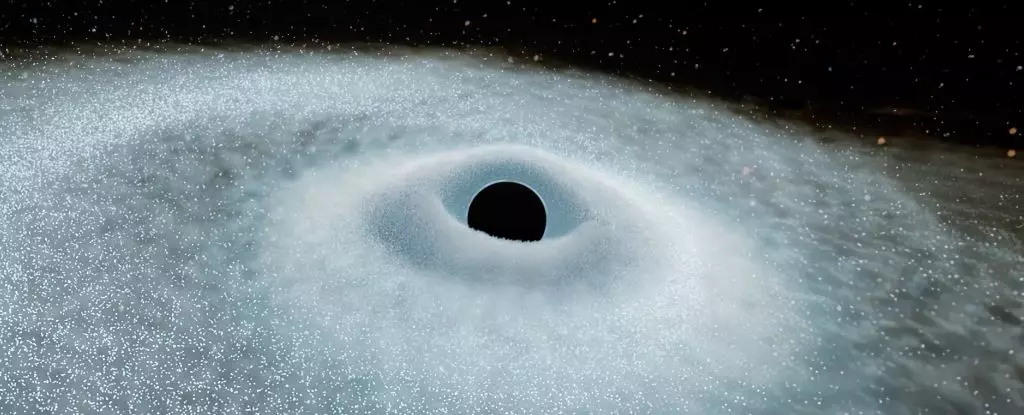The universe has a way of astonishing us, often unveiling phenomena that challenge our understanding of reality. Recently, scientists utilizing data from the Gaia space telescope made an extraordinary discovery: an unprecedented form of cosmic explosion, strikingly brighter than anything we’ve seen before. Dubbed “extreme nuclear transients” (ENTs), these extraordinary events reveal that the universe harbors secrets far beyond our prior observations. With this groundbreaking hunt for knowledge, we’re not merely studying the stars; we are witnessing the cataclysmic processes that shape galaxies.
These stellar spectacles occur when massive stars, at least three times the mass of our Sun, drift too close to supermassive black holes nestled within the centers of galaxies. The result is a dramatic cosmic interplay—a tidal disruption event (TDE)—where the gravitational pull of the black hole rips apart the star with colossal force. Scientists have previously documented TDEs, but ENTs take this radically further, boasting brightness levels nearly tenfold higher than conventional counterparts and lasting for years.
Decoding Cosmic Phenomena through Gaia
Gaia was initially launched for an ambitious mission of mapping the Milky Way, yet its extraordinary data has stretched beyond its original purpose. In its quest to capture parallax measurements of stars within our galaxy, Gaia unexpectedly recorded two hauntingly luminous flares: Gaia16aaw in 2016 and Gaia18cdj in 2018. By analyzing these samples, astrophysicists, including Jason Hinkle from the University of Hawai’i, have entered uncharted territory in understanding the energies released in these cosmic displays.
During their exploration, the researchers drew parallels between Gaia’s findings and a remarkably potent event cataloged by the Zwicky Transient Facility in 2020, whimsically named “Scary Barbie”. Not only did they find that the Gaia events shared characteristics with this awe-inspiring explosion, but they also realized that these ENTs represent something entirely novel—massive energy releases dwarfing traditional expectations of stellar behavior.
Understanding the Scale of ENTs
The scale at which ENTs release energy is staggering. Imagine the energy output of 100 Suns over their entire lifetimes compressed into a singular event that lights up the cosmos. The implications of such revelations invoke a sense of respect and awe for the unforgiving power that governs our universe. Earlier, astrophysicists could only surmise the destructive yet beautiful spectacle of tidal disruption events, but with ENTs, we have opened a Pandora’s box teeming with questions.
While they can fuel our understanding of supermassive black holes and their existence, they illuminate the limits of traditional stellar phenomena. How does a star manage to accrue so much energy in its final moments? What cosmic mechanisms enable certain stars to erupt with such ferocity? These questions beckon further exploration, tantalizing us with the possibilities for future discoveries in the field of astronomy.
Potential Implications for Astrophysics
The rarity of extreme nuclear transients—occurring roughly 10 million times less frequently than supernovae—hints at a deeper cosmic narrative that remains largely incomplete. The limited frequency of ENTs does not, however, diminish their significance; rather, it elevates their role in the astrophysical community. Their brilliance offers researchers a unique lens through which to examine the elusive supermassive black holes that populate the universe.
By studying these events in all their luminosity, scientists can draw important conclusions about the growth and evolution of black holes, a topic that remains shrouded in mystery. ENTs allow for unprecedented observations across vast cosmic distances, thus unlocking the potential for understanding distant galaxies as they existed in the past. The driving force behind the evolution of these colossal entities has implications for our understanding of both the universe’s origin and its ultimate fate.
Catalysts for Future Exploration
As we venture deeper into the cosmos, every data point gleaned from instruments like Gaia serves as a stepping stone for future exploration. These extreme nuclear transients are gateways to understanding phenomena far beyond our imagination. The awareness of ENTs empowers astronomers to redefine what cosmic explosions signify and how they can utilize these discoveries for studying the universe.
This new class of cosmic phenomena not only enriches our knowledge of gravitational interactions and stellar evolution but also underscores the still-untapped potential that the cosmos holds for us. As scientists continue their quest to decode the mysteries of black holes and structure formation in the universe, the tale of extreme nuclear transients illustrates the dynamic nature of cosmic discovery, inviting us along for an exhilarating journey into the unknown.


Leave a Reply